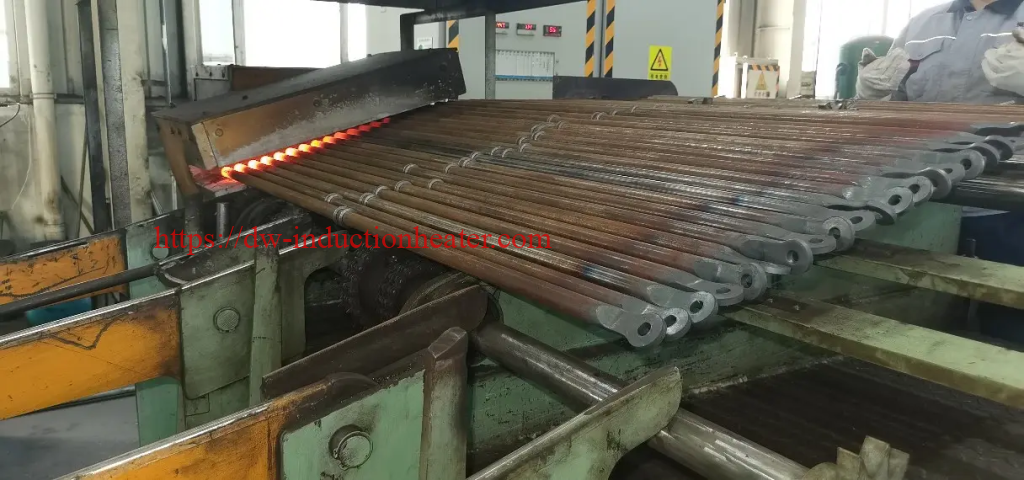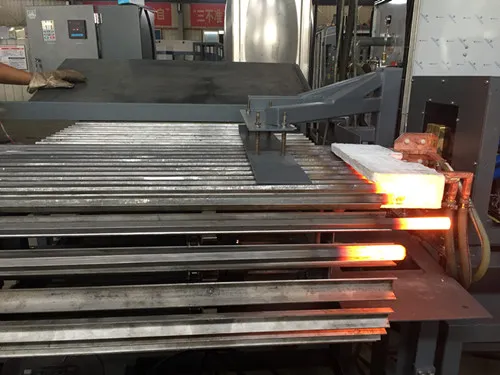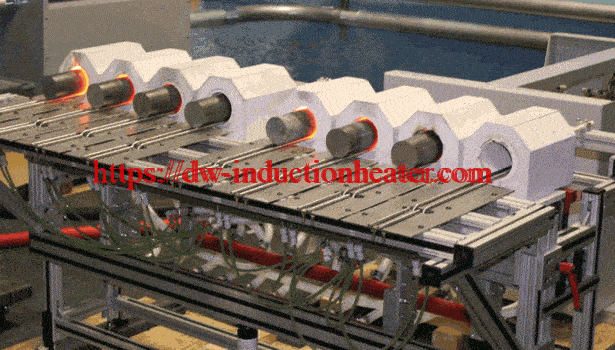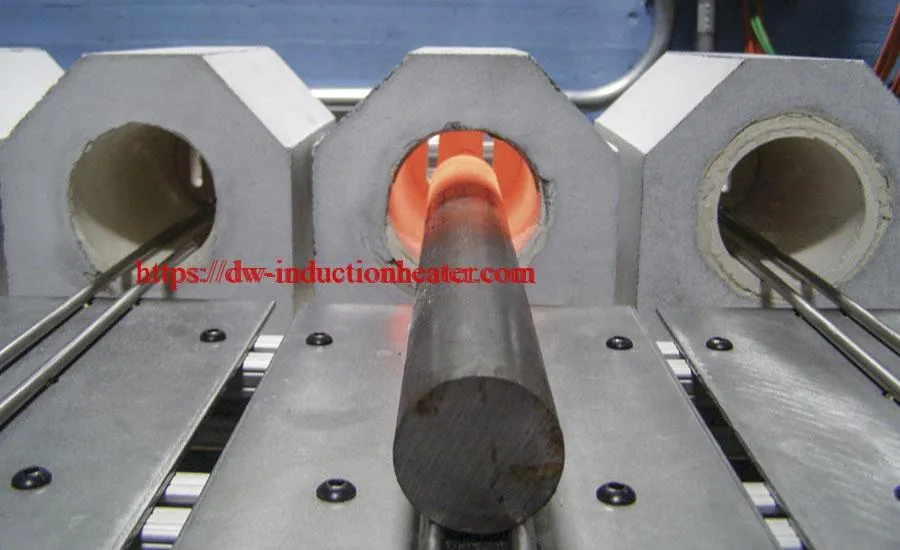
The Fundamentals and Applications of Induction Bar End Heating
Induction bar end heating is a specialized process utilized in various industrial applications where localized heating of a metal bar’s end is required. This technique leverages the principles of electromagnetic induction to achieve precise, efficient, and controlled heating. This article provides an in-depth understanding of the induction heating process, its fundamental principles, equipment involved, benefits, applications, and challenges.
 Introduction:
Introduction:
In the manufacturing and metalworking industries, precise heating techniques are paramount in molding materials to desired specifications. Induction bar end heating has emerged as a critical technology in such sectors, offering targeted heating without direct contact or combustion. This process has revolutionized tasks such as forging, forming, and fitting by providing consistent and repeatable heating cycles.
Principles of Induction Heating:
Induction heating is based on Faraday's law of electromagnetic induction, which posits that a changing magnetic field within a circuit induces a current in the circuit. In the context of induction bar end heating, an alternating current (AC) passes through an induction coil, producing a fluctuating magnetic field. When a conductive metal bar is placed within this magnetic field, eddy currents are induced in the bar. The resistance of the metal to these currents generates heat.
 Equipment and Technology:
Equipment and Technology:
The key components of an induction heating system include the induction coil, power supply, and workpiece. The coil design is crucial as it determines the efficiency and effectiveness of the heating. The power supply, typically a high-frequency generator, controls the current, voltage, and frequency supplied to the coil. Advanced systems are equipped with precise control mechanisms to regulate the heating process, ensuring uniform temperature distribution and optimizing energy consumption.
Benefits of Induction Bar End Heating:
Induction heating offers numerous advantages over traditional heating methods. Notable benefits include:
1. Selective Heating: Induction allows for localized heating of the bar end without affecting the material's properties in other areas.
2. Speed and Efficiency: The process heats materials rapidly, reducing cycle times and increasing production rates.
3. Energy Efficiency: Induction heating focuses energy directly, minimizing heat loss to the environment.
4. Consistency: Controlled parameters lead to repeatable heating cycles, ensuring uniformity in product quality.
5. Safety and Environment: The absence of open flames and reduced emissions make induction heating safer and more environmentally friendly.
 Applications:
Applications:
Induction bar end heating is applied in various sectors, including automotive, aerospace, construction, and energy. Specific applications include:
1. Forging: Preheating bar ends for subsequent hammering or pressing into desired shapes.
2. Upsetting: Localized heating to increase the cross-section of a bar end for bolt or rivet manufacturing.
3. Welding: Heating bar ends before joining them to other components.
4. Forming: Shaping metal ends for fittings, flanges, or specialized machinery parts.
Challenges and Considerations:
While induction bar end heating offers notable benefits, it also poses challenges. Material properties such as magnetic permeability and electrical resistivity affect heating efficiency. Additionally, the geometry of the workpiece requires tailored coil designs to ensure uniform heating. Advanced monitoring and control systems are necessary to maintain process consistency.
 Conclusion:
Induction bar end heating
Conclusion:
Induction bar end heating stands out as a transformative technology in metalworking, offering unparalleled precision, efficiency, and control. As industries continually seek to optimize their processes, the demand for such advanced techniques is likely to grow. Understanding the intricacies of induction heating will enable engineers and technicians to leverage this technology to its fullest potential, driving innovation and productivity in manufacturing and beyond.
 https://dw-inductionheater.com/the-fundamentals-and-applications-of-induction-bar-end-heating.html?feed_id=241600&_unique_id=661c5490c0eba
https://dw-inductionheater.com/the-fundamentals-and-applications-of-induction-bar-end-heating.html?feed_id=241600&_unique_id=661c5490c0eba

 Introduction:
In the manufacturing and metalworking industries, precise heating techniques are paramount in molding materials to desired specifications. Induction bar end heating has emerged as a critical technology in such sectors, offering targeted heating without direct contact or combustion. This process has revolutionized tasks such as forging, forming, and fitting by providing consistent and repeatable heating cycles.
Principles of Induction Heating:
Induction heating is based on Faraday's law of electromagnetic induction, which posits that a changing magnetic field within a circuit induces a current in the circuit. In the context of induction bar end heating, an alternating current (AC) passes through an induction coil, producing a fluctuating magnetic field. When a conductive metal bar is placed within this magnetic field, eddy currents are induced in the bar. The resistance of the metal to these currents generates heat.
Introduction:
In the manufacturing and metalworking industries, precise heating techniques are paramount in molding materials to desired specifications. Induction bar end heating has emerged as a critical technology in such sectors, offering targeted heating without direct contact or combustion. This process has revolutionized tasks such as forging, forming, and fitting by providing consistent and repeatable heating cycles.
Principles of Induction Heating:
Induction heating is based on Faraday's law of electromagnetic induction, which posits that a changing magnetic field within a circuit induces a current in the circuit. In the context of induction bar end heating, an alternating current (AC) passes through an induction coil, producing a fluctuating magnetic field. When a conductive metal bar is placed within this magnetic field, eddy currents are induced in the bar. The resistance of the metal to these currents generates heat. Equipment and Technology:
The key components of an induction heating system include the induction coil, power supply, and workpiece. The coil design is crucial as it determines the efficiency and effectiveness of the heating. The power supply, typically a high-frequency generator, controls the current, voltage, and frequency supplied to the coil. Advanced systems are equipped with precise control mechanisms to regulate the heating process, ensuring uniform temperature distribution and optimizing energy consumption.
Benefits of Induction Bar End Heating:
Induction heating offers numerous advantages over traditional heating methods. Notable benefits include:
1. Selective Heating: Induction allows for localized heating of the bar end without affecting the material's properties in other areas.
2. Speed and Efficiency: The process heats materials rapidly, reducing cycle times and increasing production rates.
3. Energy Efficiency: Induction heating focuses energy directly, minimizing heat loss to the environment.
4. Consistency: Controlled parameters lead to repeatable heating cycles, ensuring uniformity in product quality.
5. Safety and Environment: The absence of open flames and reduced emissions make induction heating safer and more environmentally friendly.
Equipment and Technology:
The key components of an induction heating system include the induction coil, power supply, and workpiece. The coil design is crucial as it determines the efficiency and effectiveness of the heating. The power supply, typically a high-frequency generator, controls the current, voltage, and frequency supplied to the coil. Advanced systems are equipped with precise control mechanisms to regulate the heating process, ensuring uniform temperature distribution and optimizing energy consumption.
Benefits of Induction Bar End Heating:
Induction heating offers numerous advantages over traditional heating methods. Notable benefits include:
1. Selective Heating: Induction allows for localized heating of the bar end without affecting the material's properties in other areas.
2. Speed and Efficiency: The process heats materials rapidly, reducing cycle times and increasing production rates.
3. Energy Efficiency: Induction heating focuses energy directly, minimizing heat loss to the environment.
4. Consistency: Controlled parameters lead to repeatable heating cycles, ensuring uniformity in product quality.
5. Safety and Environment: The absence of open flames and reduced emissions make induction heating safer and more environmentally friendly. Applications:
Induction bar end heating is applied in various sectors, including automotive, aerospace, construction, and energy. Specific applications include:
1. Forging: Preheating bar ends for subsequent hammering or pressing into desired shapes.
2. Upsetting: Localized heating to increase the cross-section of a bar end for bolt or rivet manufacturing.
3. Welding: Heating bar ends before joining them to other components.
4. Forming: Shaping metal ends for fittings, flanges, or specialized machinery parts.
Challenges and Considerations:
While induction bar end heating offers notable benefits, it also poses challenges. Material properties such as magnetic permeability and electrical resistivity affect heating efficiency. Additionally, the geometry of the workpiece requires tailored coil designs to ensure uniform heating. Advanced monitoring and control systems are necessary to maintain process consistency.
Applications:
Induction bar end heating is applied in various sectors, including automotive, aerospace, construction, and energy. Specific applications include:
1. Forging: Preheating bar ends for subsequent hammering or pressing into desired shapes.
2. Upsetting: Localized heating to increase the cross-section of a bar end for bolt or rivet manufacturing.
3. Welding: Heating bar ends before joining them to other components.
4. Forming: Shaping metal ends for fittings, flanges, or specialized machinery parts.
Challenges and Considerations:
While induction bar end heating offers notable benefits, it also poses challenges. Material properties such as magnetic permeability and electrical resistivity affect heating efficiency. Additionally, the geometry of the workpiece requires tailored coil designs to ensure uniform heating. Advanced monitoring and control systems are necessary to maintain process consistency. Conclusion:
Induction bar end heating stands out as a transformative technology in metalworking, offering unparalleled precision, efficiency, and control. As industries continually seek to optimize their processes, the demand for such advanced techniques is likely to grow. Understanding the intricacies of induction heating will enable engineers and technicians to leverage this technology to its fullest potential, driving innovation and productivity in manufacturing and beyond.
Conclusion:
Induction bar end heating stands out as a transformative technology in metalworking, offering unparalleled precision, efficiency, and control. As industries continually seek to optimize their processes, the demand for such advanced techniques is likely to grow. Understanding the intricacies of induction heating will enable engineers and technicians to leverage this technology to its fullest potential, driving innovation and productivity in manufacturing and beyond.

